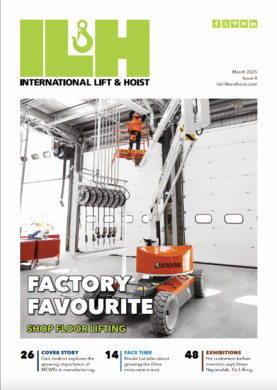)
Workplace safety – the wider benefits
Martin McVicar managing director of Combilift outlines the importance of developing a safety culture and choosing the correct equipment in modern warehousing and manufacturing facilities.
Ensuring the safest possible working environment doesn’t just mean adhering to statutory guidelines; creating and promoting a safety strategy across the workforce encourages a culture of vigilance which ensures that risks are kept to a minimum. This is particularly vital in the materials handling sector, where the combination of powered vehicles such as forklifts working in the vicinity of other employees on foot can lead to any number of potentially dangerous situations.
Accidents involving forklift trucks and pedestrians are still a major issue in spite of safety legislation. Human error is a major cause of accidents and carrying out repetitive tasks on a daily basis can also make drivers or operators of equipment somewhat complacent to the hazards, so management and the company as a whole needs to be constantly reinforcing the safety message.
Safety for our customers is at the forefront of every Combilift innovation, but it is of course a priority in our own manufacturing plant. When we set up our new facility, which was opened in 2018, a safe and efficient operating environment was paramount when designing the 46,000sqm production area. We took a lot of data from the BSI (British Standards Institution) PAS 13 guidelines for safety barrier practices and worked with A-Safe for the optimum layout of our walkways. Introducing safety barriers has worked very well and has allowed us to segregate our 600+ employees from mobile vehicles in the busy plant. The introduction of the barriers was really key to developing our facility so that it is safe for employees and visitors.
We also encourage our employees to report routine safety observations, these can be either a ‘Good Catch’ which highlighted what could have happened, or a ‘Near Miss’ – something that has happened but could have been avoided.
We also wholeheartedly support country-based or worldwide initiatives which contribute to heightened awareness of the vital importance of workplace safety, such as the World Day for Safety and Health at Work which takes place on 28 April every year. Started by the International Labour Organization (ILO) in 2003, it is an awareness-raising campaign intended to focus international attention on how promoting and creating a safety and health culture can help reduce the number of work-related deaths and injuries.
It pays to choose the right equipment
Choosing the most suitable equipment for specific handling requirements can vastly improve safety – whether you are handling relatively light pallets, long loads, containers or very heavy oversized modular structures in the warehouse, manufacturing facilities, loading bays or yards. Trying to manoeuvre long packs of steel, timber or aluminium in confined spaces with counterbalance forklifts for example is problematic. Using a couple of forklifts at either end of a load is a definite no-no from a health and safety point of view and travelling with elevated loads around obstacles is also considered to be hazardous practice.
The indirect costs of not using the right trucks can be considerable in terms of downtime after collisions, product damage or repairs for damaged racking, and administrative costs for accident investigations. Disruptive workflow, delayed deliveries and unhappy customers are further consequences. And this is without counting the much more grave human cost of any injuries that may be inflicted. What’s required are handling solutions tailored to specific challenges.
Since Combilift launched its first C4000 multidirectional forklift over 20 years ago, a cornerstone of our company’s design philosophy has been to supply innovative handling solutions that reduce risk and prevent accidents. Each of our around 30 products has been specifically developed with safety at the forefront. Our thousands of customers around the world have also come to the conclusion that putting safety first doesn’t just protect the workforce but leads to other wide ranging benefits such as improved productivity and more cost-effective operation.
Long loads
Long loads can be tricky to manoeuvre and greedy on space. Combilift’s multidirectional models were specifically designed for the demands of handling these safely and efficiently as they combine the advantages of a counterbalance forklift, sideloader and narrow aisle truck in one. The very low centre of gravity and integrated platform provides a stable base for resting loads on during transportation, eliminating the need for elevated loads. The quick change of the wheel direction enables sideways travel in confined spaces and this in turn means a much better use of all available space which is one of a company’s most valuable assets. Compared to using a counterbalance forklift, storage capacity can potentially be doubled with one of our multidirectional models. The costs of operating multiple types of vehicles are also reduced due to lower outlay on maintenance, insurance, training and so on.
AJN Steelstock supplies general and structural steel sections from its two bases in Suffolk and Somerset and was an early convert to the benefits of Combilift’s multidirectional forklifts when it acquired its first model in 2001. The company now operates a fleet of over 80 trucks, a mix of 7t and 5t capacity models. “We originally changed from counterbalance trucks to Combilifts to ensure safe as well as space saving manoeuvering of our long products – moving 18m beams with a counterbalance truck is not ideal from many points of view,” says joint managing director Alan Boyden. “We have been very happy with the robust and multi-purpose operation of the trucks, but more importantly, they make a valuable contribution to our aim to establish and maintain the highest standards of health and safety performance within our industry.”
Safer on foot
Operating at walking speed is inherently safer than using a motorised truck with a driver in a cab, and where possible, many companies are looking at using pedestrian operated trucks. The technology now integrated into the latest generation of these, such as the various models that Combilift now produces, enables them to not just handle small palettised loads but also longer products such as sheet materials, which offers more versatility. Combilift’s range includes two-directional and multidirectional Combi-WR and Combi-WR4 reachstackers, as well as the Combi-CS counterbalance design stacker. A key safety feature in all the models is the unique patented multi-position tiller arm. This can be turned to the left or right of the truck, allowing the operator to remain at the side when working in narrow aisles rather than the rear, reducing the risk of them being crushed or trapped between the truck and racking. Good all-round visibility of the load, the forks and the working environment make it safer for everyone on site, whether truck is working indoors or outside.
Medisafe, based in Bishop’s Stortford, manufactures cleaning and decontaminating solutions for surgical instruments, and recently replaced a ride-on reach truck with a Combi-CS. Due to the location of storage facilities within the relatively tight confines of the manufacturing facilities, employees work closely alongside handling equipment, and the size of the reach truck necessitated halting production when it was moving pallets or placing and picking them in the racking. The Combi-CS’s manoeuvrability and its tight turning circle has enabled aisle widths to be reduced from 2.8m to 2.3m to create more space around the truck. It is now not only safer, but as there are no more interruptions in the manufacturing schedules, it is more productive too.
Extreme loads
Any company that deals with large loads of concrete or structural steel for example is familiar with the risks that are posed when loading trailers with product ready to be sent out to customers. This can often involve the need for working at height as personnel stand on the trailer to guide forklift drivers, or to sling hooks onto loads when using cranes. To eliminate these hazards, many are turning to Combilift’s Combi-SC range of straddle carriers, the structure of which is designed to safely lift loads of uneven weight distribution with maximum stability. Lifting on four corners allows the full load to be prepared at ground level and manoeuvred securely. Once completed, the Straddle Carrier drives over the top of the load, picks it up in one lift and lowers it directly on the truck bed ready to be secured for transportation. Lifting and manoeuvring even the heaviest and very cumbersome loads is no problem for the Combi-SC. Its optimum centre of gravity, broad wheelbase and exceptional 3-wheel manoeuvrability ensure maximum load stability. And there are many other benefits, as Mike Nesbitt, equipment manager at Schulte Building Systems in the US explains, “Doing something the safer way has ended up being the more profitable way too. Our Combi-SCs have not only improved safety in the shop floors and yards but have halved the time it takes to build a load, reduced labour costs and boosted profits.”
Avoid overloading
Overloaded vehicles can tip and fall, resulting not only in damage to vehicles and stock, but at worst can cause serious or fatal injuries to personnel. There are several factors that can influence a forklift truck to become overloaded. The load centre – the distance from the face of fork to the centre of gravity of the load – plays a crucial part. Drivers who are insufficiently aware of their forklift’s load capacity and the associated risks of exceeding it not only compromise their own safety, but also that of everyone working around them. But as we cannot expect forklift operators to have to constantly do the maths, we need to make life easier – and safer – for them. The optional Combilift Safe-Lift is an anti-overload device which enables drivers to avoid the pitfalls of potential overloading. It incorporates a strain sensor on the mast and a lift cut-out valve positioned on the mast hydraulic lift hose. There is an audible alarm which warns the operator of an overload situation and an indicator unit is fitted to the dashboard in the cab. The operator can instantly see from the green, amber and red “traffic light” signalling when there is a risk of overloading or when the forks are not fully engaged for example and take appropriate action.











